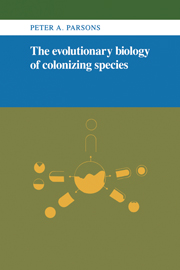Book contents
- Frontmatter
- Contents
- Preface
- 1 Introduction: Colonists and habitats
- 2 Genetics and ecology
- 3 Physical conditions, resources, and ecological phenotypes
- 4 Variability in natural populations
- 5 Genetic variability, ecological phenotypes, and stressful environments
- 6 Colonizing phenotypes and genotypes
- 7 Behavioral variability in natural populations
- 8 Habitat selection
- 9 The ecobehavioral phenotype: generalists and specialists
- 10 The ecobehavioral phenotype: biological control and domestication
- 11 Parasites and plants
- 12 Discussion and conclusions
- Appendix The study of quantitative traits
- References
- Index
7 - Behavioral variability in natural populations
Published online by Cambridge University Press: 15 September 2009
- Frontmatter
- Contents
- Preface
- 1 Introduction: Colonists and habitats
- 2 Genetics and ecology
- 3 Physical conditions, resources, and ecological phenotypes
- 4 Variability in natural populations
- 5 Genetic variability, ecological phenotypes, and stressful environments
- 6 Colonizing phenotypes and genotypes
- 7 Behavioral variability in natural populations
- 8 Habitat selection
- 9 The ecobehavioral phenotype: generalists and specialists
- 10 The ecobehavioral phenotype: biological control and domestication
- 11 Parasites and plants
- 12 Discussion and conclusions
- Appendix The study of quantitative traits
- References
- Index
Summary
Behavior genetics did not exist as a special field until about 1960. Since that time it has grown considerably.
[Caspari, 1977:4]Following the predominantly ecological considerations so far, the aim of this chapter is to look at behavioral variation with particular emphasis on natural populations. Behavior can be regarded as of great importance in evolutionary change, whether considering aspects concerned with mating or improving adaptedness to a new environment. Behaviors relevant to population continuity need to be isolated and studied under a multiplicity of environments. Assuming that measurement is objective, that is, independent of the observer, there are two emphases that are important in the study of behavioral traits. They are the difficulty of environmental control and the importance of learning (Ehrman and Parsons, 1981a). The first emphasis will be discussed in this chapter mainly with Drosophila examples. The second will be considered to some extent in the next chapter, being of greatest importance in organisms higher in the phylogenetic series.
Phototaxis and light intensities
Hirsch and Boudreau (1958) studied phototaxis (movement with respect to light) in D. melanogaster in an apparatus consisting of a Y maze (part of Figure 7.1C), one arm of which was exposed to light during tests. Quite rapid responses to directional selection were found for both positive and negative phototaxis, which is reasonable as a heritability in the broad sense was estimated in excess of 0.5. Similarly, responses to selection have been found in D. melanogaster (Hadler, 1964) and in D. pseudoobscura (Dobzhansky and Spassky, 1969) for phototaxis in more complex mazes (Figure 7.1C).
- Type
- Chapter
- Information
- The Evolutionary Biology of Colonizing Species , pp. 109 - 135Publisher: Cambridge University PressPrint publication year: 1983



